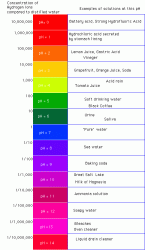waterdrop
Enthusiastic "Re-Beginner"
Actually, fishless cycles do go very nicely with a bare tank or even a bare tank wrapped in black plastic to block light. It's just that usually there is a family involved and often someone in the family will rebel about a black tank sitting in the room for weeks. The blacked out tank keeps you from getting algae and also helps the bacteria grow a little since they grow best in the dark.
In your situation it might be good to start with fish food dosing and continue to search for the right sort of simple household ammonia. An ammonia dosed fishless cycle is much more easily controlled and understood, which is why we do them instead of straight fishfood cycles. As mentioned, we know the best places to find the right ammonia in the USA and in the UK but in other places we've had people find success at universities and pharmacies/chemists or sometimes other businesses. The solution is typically less than 10% concentration of pure ammonia gas in distilled water (often called aqueous ammonia) and it's important that it not have dyes, fragrances, surfactants or other soap additives. When you shake it you should see a few big bubbles for 2 or 3 seconds just like water, rather than seeing foam. Anyway it is very much worth the search for the right ammonia and the members often enjoy hearing how this goes and offering suggestions.
There are several other things needed besides ammonia. A good liquid-reagent water test kit is necessary. Most of us like and use the API Freshwater Master Test Kit or the Nutrafin Mini-Master Test Kit. There are also Salifert individual tests that are slightly more involved but also more accurate and reliable in some instances. Don't get paper strip tests, they are worse than useless, the results can lead to wrong decisions. Along with any liquid test kit it is good to get a syringe from a pharmacy to help you get the required 5ml or so of water in to the test tube easily. If you find ammonia then it's good to get two syringes. A good conditioner is important. Many of us like and use Seachem Prime for this, especially for the first year or two as it can give some additional help for beginner mistakes. The main purpose of conditioner though is to neutralize the chlorine or chloramines that the are put in tap water (this assumes you use tap water.) During cycling I recommend that beginners dose conditioner at 1.5x to 2x whatever the instructions tell you, but not more than 2x conditioner overdosing.
Sorry, I know that's a lot of little details but often it allows you to look back later for things. The members here are great so they'll help you as you go along.
~~waterdrop~~
In your situation it might be good to start with fish food dosing and continue to search for the right sort of simple household ammonia. An ammonia dosed fishless cycle is much more easily controlled and understood, which is why we do them instead of straight fishfood cycles. As mentioned, we know the best places to find the right ammonia in the USA and in the UK but in other places we've had people find success at universities and pharmacies/chemists or sometimes other businesses. The solution is typically less than 10% concentration of pure ammonia gas in distilled water (often called aqueous ammonia) and it's important that it not have dyes, fragrances, surfactants or other soap additives. When you shake it you should see a few big bubbles for 2 or 3 seconds just like water, rather than seeing foam. Anyway it is very much worth the search for the right ammonia and the members often enjoy hearing how this goes and offering suggestions.
There are several other things needed besides ammonia. A good liquid-reagent water test kit is necessary. Most of us like and use the API Freshwater Master Test Kit or the Nutrafin Mini-Master Test Kit. There are also Salifert individual tests that are slightly more involved but also more accurate and reliable in some instances. Don't get paper strip tests, they are worse than useless, the results can lead to wrong decisions. Along with any liquid test kit it is good to get a syringe from a pharmacy to help you get the required 5ml or so of water in to the test tube easily. If you find ammonia then it's good to get two syringes. A good conditioner is important. Many of us like and use Seachem Prime for this, especially for the first year or two as it can give some additional help for beginner mistakes. The main purpose of conditioner though is to neutralize the chlorine or chloramines that the are put in tap water (this assumes you use tap water.) During cycling I recommend that beginners dose conditioner at 1.5x to 2x whatever the instructions tell you, but not more than 2x conditioner overdosing.
Sorry, I know that's a lot of little details but often it allows you to look back later for things. The members here are great so they'll help you as you go along.
~~waterdrop~~



